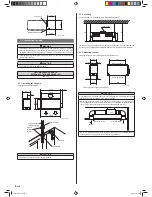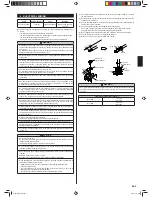
En-5
4.
PIPE INSTALLATION
CAUTION
• Be careful that foreign matter (oil, water, etc.) does not enter the piping with
refrigerant R410A models. Also, when storing the piping, securely seal the openings
by pinching, taping, etc.
• While brazing the pipes, be sure to purge with dry nitrogen gas.
4.1. Selecting the pipe material
CAUTION
• Do not use existing pipes.
• Use pipes that have clean external and internal sides without any contamination
which may cause trouble during use, such as sulfur, oxide, dust, cutting waste, oil, or
water.
• It is necessary to use seamless copper pipes.
Material : Phosphor deoxidized seamless copper pipes
It is desirable that the amount of residual oil is less than 40 mg/10 m.
• Do not use copper pipes that have a collapsed, deformed, or discolored portion
(especially on the interior surface). Otherwise, the expansion valve or capillary tube
may become blocked with contaminants.
• Improper pipe selection will degrade performance. As an air conditioner using R410A
incurs pressure higher than when using conventional refrigerant, it is necessary to
choose adequate materials.
•
Thicknesses of copper pipes used with R410A are as shown in the table.
•
Never use copper pipes thinner than those indicated in the table even if they are
available on the market.
Thicknesses of Annealed Copper Pipes (R410A)
Pipe outside diameter [mm (in.)]
Thickness [mm]
6.35 (1/4)
0.80
9.52 (3/8)
0.80
12.70 (1/2)
0.80
15.88 (5/8)
1.00
19.05 (3/4)
1.20
4.2. Pipe requirement
CAUTION
• Refer to the Installation Manual of the outdoor unit for description of the length of
connecting pipe or for difference of its elevation.
Diameter [mm (in.)]
Liquid
9.52 (3/8)
Gas
15.88 (5/8)
• Use pipe with water-resistant heat insulation.
CAUTION
• Install heat insulation around both the gas and liquid pipes. Failure to do so may
cause water leaks.
Use heat insulation with heat resistance above 120 °C. (Reverse cycle model only)
In addition, if the humidity level at the installation location of the refrigerant piping is
expected to exceed 70 %, install heat insulation around the refrigerant piping. If the
expected humidity level is 70-80 %, use heat insulation that is 15 mm or thicker and
if the expected humidity exceeds 80 %, use heat insulation that is 20 mm or thicker.
If heat insulation is used that is not as thick as speci
fi
ed, condensation may form on
the surface of the insulation. In addition, use heat insulation with heat conductivity of
0.045 W/(m·K) or less (at 20 °C).
4.3. Flare connection (Pipe connection)
WARNING
• Tighten the
fl
are nuts with a torque wrench using the speci
fi
ed tightening method.
Otherwise, the
fl
are nuts could break after a prolonged period, causing refrigerant to
leak and generate a hazardous gas if the refrigerant comes into contact with a
fl
ame.
4.3.1. Flaring
• Use special pipe cutter and
fl
are tool exclusive for R410A.
(1) Cut the connection pipe to the necessary length with a pipe cutter.
(2) Hold the pipe downward so that cuttings will not enter the pipe and remove any
burrs.
(3) Insert the
fl
are nut (always use the
fl
are nut attached to the indoor and outdoor
units respectively) onto the pipe and perform the
fl
are processing with a
fl
are tool.
Use the special R410A
fl
are tool, or the conventional
fl
are tool. Leakage of refriger-
ant may result if other
fl
are nuts are used.
(4) Protect the pipes by pinching them or with tape to prevent dust, dirt, or water from
entering the pipes.
L
Die
Pipe
A
B
Check if [L] is
fl
ared uniformly
and is not cracked or scratched.
Pipe outside diameter
[mm (in.)]
Dimension A [mm]
Dimension B
-
0
0.4
[mm]
Flare tool for R410A,
clutch type
6.35 (1/4)
0 to 0.5
9.1
9.52 (3/8)
13.2
12.70 (1/2)
16.6
15.88 (5/8)
19.7
19.05 (3/4)
24.0
When using conventional
fl
are tools to
fl
are R410A pipes, the dimension A should be ap-
proximately 0.5 mm more than indicated in the table (for
fl
aring with R410A
fl
are tools)
to achieve the speci
fi
ed
fl
aring. Use a thickness gauge to measure the dimension A.
Width across
fl
ats
Pipe outside
diameter [mm (in.)]
Width across flats
of Flare nut [mm]
6.35 (1/4)
17
9.52 (3/8)
22
12.70 (1/2)
26
15.88 (5/8)
29
19.05 (3/4)
36
4.3.2. Bending pipes
•
If pipes are shaped by hand, be careful not to collapse them.
•
Do not bend the pipes in an angle more than 90°.
•
When pipes are repeatedly bend or stretched, the material will harden, making it
dif
fi
cult to bend or stretch them any more.
•
Do not bend or stretch the pipes more than 3 times.
CAUTION
• To prevent breaking of the pipe, avoid sharp bends.
• If the pipe is bent repeatedly at the same place, it will break.
4.3.3. Pipe connection
CAUTION
• Be sure to install the pipe against the port on the indoor unit correctly. If the centering
is improper, the
fl
are nut cannot tighten smoothly. If the
fl
are nut is forced to turn, the
threads will be damaged.
• Do not remove the flare nut from the indoor unit pipe until immediately before
connecting the connection pipe.
• Do not use mineral oil on
fl
ared part. Prevent mineral oil from getting into the system
as this would reduce the lifetime of the units.
9379123037-02.indb 5
9379123037-02.indb 5
7/4/12 3:47 PM
7/4/12 3:47 PM

































